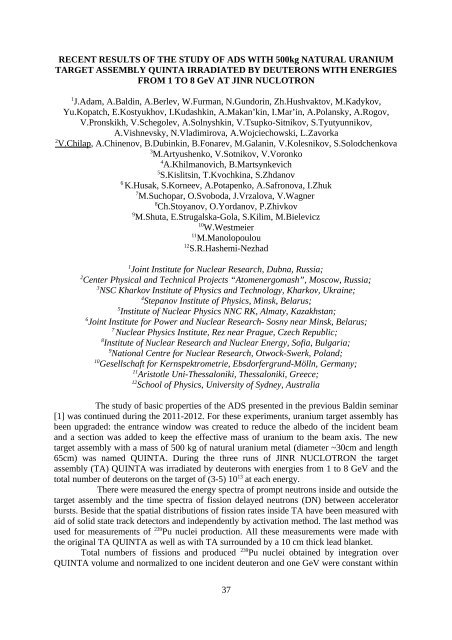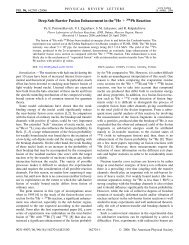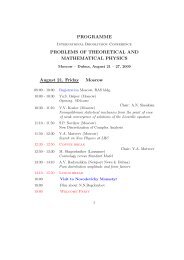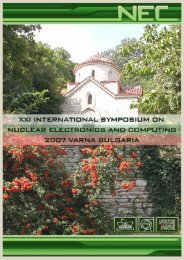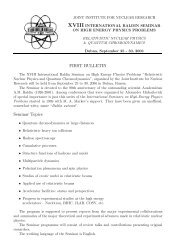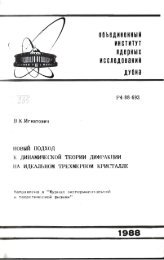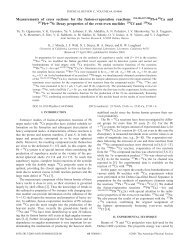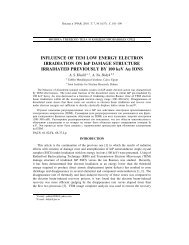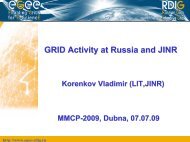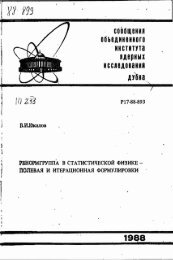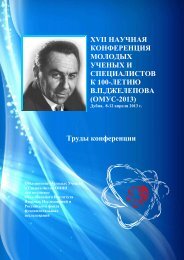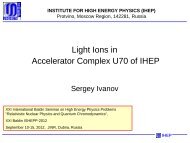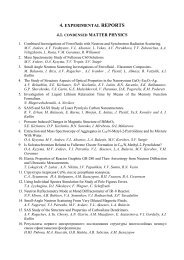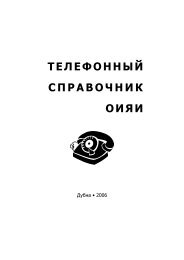Joint Institute for Nuclear Research Relativistic ... - Index of - JINR
Joint Institute for Nuclear Research Relativistic ... - Index of - JINR
Joint Institute for Nuclear Research Relativistic ... - Index of - JINR
Create successful ePaper yourself
Turn your PDF publications into a flip-book with our unique Google optimized e-Paper software.
RECENT RESULTS OF THE STUDY OF ADS WITH 500kg NATURAL URANIUM<br />
TARGET ASSEMBLY QUINTA IRRADIATED BY DEUTERONS WITH ENERGIES<br />
FROM 1 TO 8 GeV AT <strong>JINR</strong> NUCLOTRON<br />
1<br />
J.Adam, A.Baldin, A.Berlev, W.Furman, N.Gundorin, Zh.Hushvaktov, M.Kadykov,<br />
Yu.Kopatch, E.Kostyukhov, I.Kudashkin, A.Makan’kin, I.Mar’in, A.Polansky, A.Rogov,<br />
V.Pronskikh, V.Schegolev, A.Solnyshkin, V.Tsupko-Sitnikov, S.Tyutyunnikov,<br />
A.Vishnevsky, N.Vladimirova, A.Wojciechowski, L.Zavorka<br />
2<br />
V.Chilap, A.Chinenov, B.Dubinkin, B.Fonarev, M.Galanin, V.Kolesnikov, S.Solodchenkova<br />
3<br />
M.Artyushenko, V.Sotnikov, V.Voronko<br />
4<br />
A.Khilmanovich, B.Martsynkevich<br />
5<br />
S.Kislitsin, T.Kvochkina, S.Zhdanov<br />
6<br />
K.Husak, S.Korneev, A.Potapenko, A.Safronova, I.Zhuk<br />
7<br />
M.Suchopar, O.Svoboda, J.Vrzalova, V.Wagner<br />
8<br />
Ch.Stoyanov, O.Yordanov, P.Zhivkov<br />
9<br />
M.Shuta, E.Strugalska-Gola, S.Kilim, M.Bielevicz<br />
10<br />
W.Westmeier<br />
11<br />
M.Manolopoulou<br />
12<br />
S.R.Hashemi-Nezhad<br />
1<br />
<strong>Joint</strong> <strong>Institute</strong> <strong>for</strong> <strong>Nuclear</strong> <strong>Research</strong>, Dubna, Russia;<br />
2<br />
Center Physical and Technical Projects “Atomenergomash”, Moscow, Russia;<br />
3<br />
NSC Kharkov <strong>Institute</strong> <strong>of</strong> Physics and Technology, Kharkov, Ukraine;<br />
4<br />
Stepanov <strong>Institute</strong> <strong>of</strong> Physics, Minsk, Belarus;<br />
5<br />
<strong>Institute</strong> <strong>of</strong> <strong>Nuclear</strong> Physics NNC RK, Almaty, Kazakhstan;<br />
6<br />
<strong>Joint</strong> <strong>Institute</strong> <strong>for</strong> Power and <strong>Nuclear</strong> <strong>Research</strong>- Sosny near Minsk, Belarus;<br />
7<br />
<strong>Nuclear</strong> Physics <strong>Institute</strong>, Rez near Prague, Czech Republic;<br />
8<br />
<strong>Institute</strong> <strong>of</strong> <strong>Nuclear</strong> <strong>Research</strong> and <strong>Nuclear</strong> Energy, S<strong>of</strong>ia, Bulgaria;<br />
9<br />
National Centre <strong>for</strong> <strong>Nuclear</strong> <strong>Research</strong>, Otwock-Swerk, Poland;<br />
10<br />
Gesellschaft <strong>for</strong> Kernspektrometrie, Ebsdorfergrund-Mölln, Germany;<br />
11<br />
Aristotle Uni-Thessaloniki, Thessaloniki, Greece;<br />
12<br />
School <strong>of</strong> Physics, University <strong>of</strong> Sydney, Australia<br />
The study <strong>of</strong> basic properties <strong>of</strong> the ADS presented in the previous Baldin seminar<br />
[1] was continued during the 2011-2012. For these experiments, uranium target assembly has<br />
been upgraded: the entrance window was created to reduce the albedo <strong>of</strong> the incident beam<br />
and a section was added to keep the effective mass <strong>of</strong> uranium to the beam axis. The new<br />
target assembly with a mass <strong>of</strong> 500 kg <strong>of</strong> natural uranium metal (diameter ~30cm and length<br />
65cm) was named QUINTA. During the three runs <strong>of</strong> <strong>JINR</strong> NUCLOTRON the target<br />
assembly (TA) QUINTA was irradiated by deuterons with energies from 1 to 8 GeV and the<br />
total number <strong>of</strong> deuterons on the target <strong>of</strong> (3-5) 10 13 at each energy.<br />
There were measured the energy spectra <strong>of</strong> prompt neutrons inside and outside the<br />
target assembly and the time spectra <strong>of</strong> fission delayed neutrons (DN) between accelerator<br />
bursts. Beside that the spatial distributions <strong>of</strong> fission rates inside TA have been measured with<br />
aid <strong>of</strong> solid state track detectors and independently by activation method. The last method was<br />
used <strong>for</strong> measurements <strong>of</strong> 239 Pu nuclei production. All these measurements were made with<br />
the original TA QUINTA as well as with TA surrounded by a 10 cm thick lead blanket.<br />
Total numbers <strong>of</strong> fissions and produced 239 Pu nuclei obtained by integration over<br />
QUINTA volume and normalized to one incident deuteron and one GeV were constant within<br />
37


